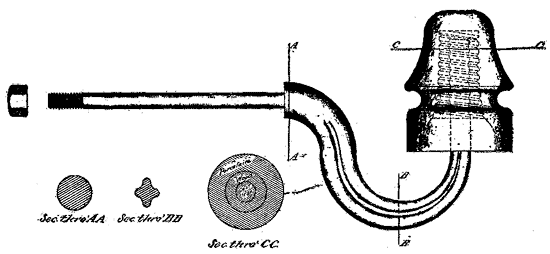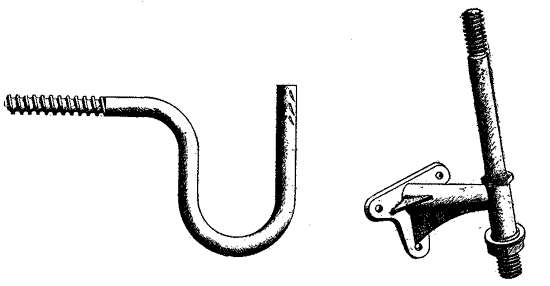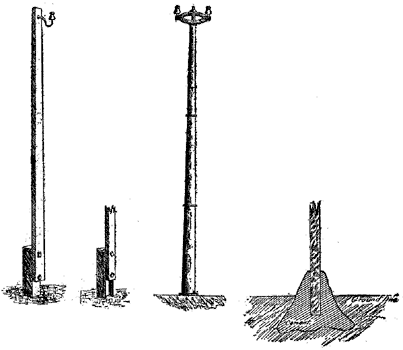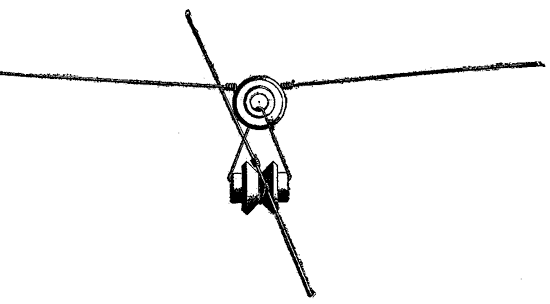[Trade Journal]
Publication: The Electrical Engineer
New York, NY, United States
vol. XVI, no. 290, p. 443-444, col. 1-2
TELEPHONE AND TELEGRAPH CONSTRUCTION IN
THE TROPICS
By Francis R. Hait
Although the same general conditions and methods of outside electrical construction prevail in all countries and in all latitudes, yet climatic influences necessarily affect minor points, and make a method of construction which in a dry and cool climate would be satisfactory very troublesome in a moist, warm country, heavily overgrown with vegetation.
The object of this paper is to point out the details of telephone and telegraph line construction which are most important in tropical countries, and some of which the Northern superintendent of construction would possibly be liable to overlook.
In the North, snow, ice, contraction by cold, and the proximity of other wires, are the chief sources of trouble in the construction and maintenance of lines. In the South, the first three are of course wholly missing and it is very seldom that wires are so numerous and so near as to become troublesome either by crowding or by induction. On the other hand the workman in tropical countries has difficulties to overcome which are quite different from those of the North, but which nevertheless must be carefully considered and overcome.
Throughout the greater part of the tropics for a considerable portion of the year the climate is excessively moist and warm, making the insulation of the line much more difficult. The rapidly growing vines, trees and the various and beautiful plants of the family Orchidacoe, present, however, a greater difficulty than all the others. Luxuriant vegetation springs up with almost the marvelous rapidity of "Jack's" famous bean stalk. Heavy branches which are one day 10 or 12 feet above the line, when weighed down by a tropical downpour of rain rest and catch on the wires. Thick stemmed, moist vine stalks run rapidly up poles and guy wires and twist their wire-like tendrils firmly and closely around the wires; and palm branches, blowing in the wind, weave their trough leaves between parallel lines. The rapidly rising rivers, the torrents which during the rains may pour through every furrow and hollow at other times dry, and the wash of gutters and culverts, make in many places almost insurmountable difficulties to permanent and economical construction.
 |
| Fig. 1. |
Taking up each part of the construction separately, I shall point out what experience has shown to be satisfactory.
Wire: - Copper or bronze are by far the best and often in the end the cheapest wires, but a very satisfactory method is to use the very best galvanized iron wires for the principal parts of the lines and to put in sections of copper or bronze in the marshy and sea-coast places.
 |
| Figs. 2 and 3.. |
Insulators: - Porcelain insulators, although slightly more expensive, should be used in preference to glass on all telephone lines. The supports for insulators should be of a form easily and securely fastened onto the poles; nothing more unsatisfactory could be devised than the American form of wooden bracket secured by nails or spikes, it being a question of weeks rather than of months or years, before the rotting of the wood around the nails permits the bracket to be drawn off. Wooden pins set in cross-arms are equally unsubstantial. Iron brackets, preferably galvanized, of one of the forms shown in Figs. 1, 2 and 3, are very good supports for the insulators shown in Figs. 4, 5, 6, and 7. The bracket shown in Fig. 1 has certain advantages as it requires no screws and will hang securely to the pole even after the surrounding wood has decayed to a considerable extent. Forms of insulators for use in heavily wooded districts will be noted under the heading "Construction."
 |
| Figs. 4, 5, 6 and 7. |
Poles: - The woods which in the North are safe from decay for many years are practically valueless in the South.
Yellow pine, thoroughly creosoted with sixteen to eighteen pounds of creosote per cubic-foot makes a fair footing to a pole, but is both expensive and inconvenient. For wooden poles some of the native woods are found to be both cheap and lasting; the particular country and conditions must control this. If sufficiently long poles cannot be secured of native woods, a very good arrangement is to make footings of either durable native woods, as shown in Fig. 8, or of railway irons, as shown in Fig. 9, securely bolting a lighter wooden pole onto these. Iron poles have but one disadvantage, that is of large first cost. The British government use a large number of poles like that illustrated in Fig. 10. The "guy" or "brace" is equally serviceable in tension or compression.
 |
| Figs. 8, 9, 10 and 11. |
General Construction: - If pole-setting is done during the dry season, as it usually must be, the greatest care must be taken in locating and setting in such a way as to avoid future disaster from standing or running water. Braces and guys must be plentiful and so placed as to avoid, so far as possible, giving a ready support for climbing plants. Where substantial soil cannot be found, and the ordinary expedients of gravel or broken stone are an insufficient safeguard, a very good way is to make a cone-shaped base of rough cement as shown in Fig. 11; this will often support a pole even if its base becomes temporarily the center of a foaming torrent.
 |
| Fig. 12. |
Supports by trees must be avoided where practicable; the reasons for this which apply in the North are trebly forcible in the South where vegetable growth is many times as rapid. The sketches, Figs. 12 and 13, give some hints, however, of a very satisfactory method of crossing heavily wooded districts and jungles.
 |
| Fig. 13. |
The necessity for protection from lightning varies, of course, with countries and districts and can be accomplished by the same expedients in use in the North.
For office construction and equipment the requirements vary little from the general rule. Owing to greater dampness ordinary office wire and wooden cleats are unsafe, and rubber and porcelain must be used.
Maintenance of Lines: - On nearly every telegraph and telephone in the tropics the one thing needing greatest attention is that to which it is the most difficult to get employes to attend; that is, properly "bushing" the line. It is not only necessary to trim and cut back the vegetation at regular intervals of a few weeks, but it must be done either during or immediately after heavy rains.
I have seen a half-mile section of line which, when inspected, had not one "ground," develop seventy-three contacts with branches and leaves within five hours after the inspector had reported it as clear of brush. This, of course, was the effect of a heavy rain, and must be provided for in advance by watchfulness on the part of the section lineman.
A careful regard for the details pointed out, with strictly first-class work in all other respects, together with freedom from any disturbing electrical influences, make it possible to maintain in the tropics lines which should give a service superior if anything to those of the North.
